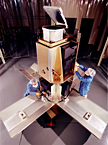- Number 308 |
- March 29, 2010
MTI satellite celebrates 10 years in orbit, continues to serve

The Multispectral
Thermal Imager
satellite has been
in service for 10
years and recently
completed its
55,000th orbit.
For researchers at DOE's Sandia National Laboratories, the evening of March 12 marked a proud moment. Hundreds of miles above the Earth, the Multispectral Thermal Imager satellite reached its 10th anniversary in service as it completed its 55,000th orbit—far exceeding both its intended maximum life and its potential applications in the process.
“The MTI satellite project is a terrific example of how NNSA and the Department of Energy leverage the best science and engineering in the world to advance nonproliferation efforts and promote national security,” NNSA Administrator Thomas D’Agostino said. “The multilaboratory team has consistently demonstrated the critical role our national laboratories play in tackling the most challenging problems facing our nation and the world.”
NNSA sponsored the MTI satellite project as a tri-lab effort to develop and evaluate advanced space-based technology for nonproliferation treaty monitoring and other national security and civilian applications. The project was carried out by DOE’s Savannah River National Laboratory and NNSA’s Los Alamos and Sandia laboratories, with Sandia serving as the lead lab, responsible for the systems engineering, integration, testing, launch support, and on-orbit operations.
“This has been an exhilarating program to be a part of,” says Randy Bell, director of the Office of Nuclear Detonation Detection and former MTI program manager. “[The MTI program] achieved many firsts in satellite engineering and remote sensing science. The program relied on a small, experienced, dedicated core team that ensured there was great technical and programmatic communications across all subsystems and science elements.”
Originally intended for a one- to three-year mission, the MTI satellite was designed to measure temperatures on the ground from space with an accuracy of one degree Celsius across 15 spectral bands. Analysts armed with advanced computer simulation codes and expertise could then employ these precision multispectral and thermal imaging capabilities to scan facilities believed to be involved in nuclear proliferation. The temperature data collected by the satellite are important because heat is a characteristic that is difficult to hide and serves as a strong indicator of a facility’s function and throughput—producing power or nuclear weapons material.
After reaching the DOE program’s three-year goal, the satellite was still functional and providing important data, said Brian Post, MTI project lead. NNSA made the MTI system available to other users for government-sponsored research in the national interest after the satellite had completed its initial goals. As it turned out, the 15 spectral bands that the MTI team had selected for the nonproliferation mission also provide valuable data to scientists who study a vast array of geophysical and other phenomena— applications never envisioned by MTI developers. In addition to numerous defense-related applications, the more than 100 members of the MTI users group have employed the satellite’s imagery for research in volcanology, glaciology, entomology, climatology, and the study of the moon.
With sponsorship secured for the foreseeable future of the MTI satellite, the project team looks forward to years of continued work supporting research and development interests.
Submitted by DOE's Sandia National Laboratories
